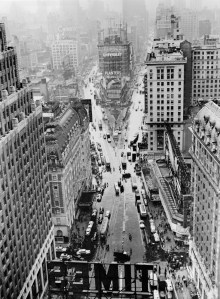
The same year that Times Square became Times Square, the Astor Hotel opened for business. It was 1904, and The New York Times had just arrived in the neighborhood, erecting its headquarters on West 43rd Street. Like the paper of record of that day, The New York Herald, The Times wanted to paste its name on a piece of Manhattan. If not the respectable midtown square that bore its rival’s flag, then The Times would settle for the next best thing: a patch of cramped factories and whorehouses rubbing up against the steadily encroaching theater district. That year also marked the long-awaited completion of the subway’s first line, and with it, the masses came reeling through the Times Square turnstiles. By 1910, the square had undergone its first unlikely metamorphosis, transforming itself into an incandescent spectacle of acrobats and escape acts, vaudeville and ragtime—an electric Milky Way of gleaming signs.
With its ornate rooftop gardens and banquet halls, its unabashed gilded fervor, the Astor Hotel on Broadway became a point of congregation for the city’s society crowd—mayors, industrial tycoons, socialites, ex-royalty. But the hotel was known best for its bar, a place where Times Square’s true royalty, its showbiz luminaries, gathered to gossip and flirt, where Cole Porter could sip absinthe, kiss Monty Woolley and sing, “Have you heard that Mimsie Starr just got pinched in the Astor Bar?”
It was almost a century later that Times Square emerged from an even unlikelier transformation, but in many ways, the block between 44th and 45th streets stayed true to the spirit of Mr. Porter’s swell party.
By 1999, at 3:30 on weekday afternoons, close to a million viewers nationwide would tune their televisions to MTV. Mostly aged 12 to 17, they were the very demographic Viacom executives were congratulating themselves for sinking Sumner Redstone’s wizened teeth into. But it was the teenagers right outside Viacom’s corporate offices that would turn out to have the far more lasting impact.
The throngs assembled beneath MTV’s glass studio for the taping of Total Request Live endowed the show with the fervid pitch of religious hysteria. Mostly teenage girls, some of them held handmade signs, and all of them screamed. They’d made the pilgrimage to Times Square on the believer’s gamble that they’d catch a glimpse of Britney Spears or 98 Degrees, or maybe even be among the chosen few ushered up to the second-floor studio. It took a few decades, a few revolutions in the saga of Times Square’s reincarnation, but at the building that sprung from the ruins of the Astor Hotel, the cult of celebrity was alive and well.
At least, it was until recently. Total Request Live, the countdown music video show, made its final run in 2008, though it had ceased being live sometime before. Then, at the end of 2009, MTV shuttered the famous studio altogether. (Tween mall staple Aeropostale will take the retail space below it, though the studio remains empty.) While Viacom, which rents about 95 percent of 1515 Broadway, renewed its lease for roughly 1.27 million square feet of office space in 2008, the era of screaming teenagers on the street was over.
What happened, of course, was bigger than MTV, bigger than Viacom, bigger even then Times Square. But 1515 Broadway had a front seat to the glimmering spectacle.
When the Astor was razed in 1967 to make way for 1515 Broadway, a cry went up for the passing of a long-gone era’s opulent relic. It didn’t help that the tower that supplanted it was a glass-and-steel monolith so tall you had to be down the street to see its sole defining feature: concrete fins sprouting from the roof with all the manic zeal of a tinfoil cap.
The Astor may have helped launch Times Square’s first glitz-bedazzled reincarnation, but the leviathan that replaced it presaged the next. The first tower to take advantage of the city’s Times Square redevelopment subsidies, 1515 Broadway commenced the spasm of high-rise construction that enveloped the area in the 1970s and 1980s. At the time, the district was filled with historic, derelict theaters, and it consistently placed both first and second in city felony rates (the area runs the fault line of two police precincts). In the name of redevelopment, city officials allowed unusually large office buildings to be built atop leveled theaters, with the one provision that a new theater be incorporated into the space.
In 1967, the developer Sam Minskoff & Sons acquired the Astor for $10.6 million. To design its successor, Minskoff commissioned Ely Jaques Kahn, a man whose architectural legacy is perhaps upstaged by his fictional one. In 1937, a budding, blocked novelist known as Ayn Rand spent six months in Mr. Kahn’s office, volunteering as a file clerk while she worked out the elusive gaps in what would become The Fountainhead. Guy Francon, the social-climbing, mediocre architect, was inspired by her boss. By 1972, the 2 million-square-foot 1515 Broadway, with its conciliatory Minskoff Theater, stood in the Astor’s place—a 54-story ode to moneymaking that would have done Rand proud.



